Publications

June 14, 2011
This brief summarizes recent regional patterns of natural decrease in the United States. Natural decrease occurs when more deaths than births occur in an area in a given year. The growing incidence of natural decrease has gone largely unnoticed, yet natural decrease is no longer an isolated phenomenon occurring in a few remote corners of the country. Last year, 24 percent of all U.S. counties…
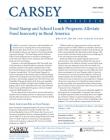
July 1, 2007
The Food Stamp and the National School Lunch Programs play a vital role in helping poor, rural Americans obtain a more nutritious diet and alleviate food insecurity and hunger. This fact sheet looks at the extent to which rural America depends on these programs and describes characteristics of beneficiaries of these federal nutrition assistance programs.
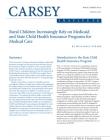
May 10, 2007
Despite a flurry of reports on health insurance coverage for children, virtually none of them have examined the unique situation of rural families where one-fifth of all the nation's poor children live. This brief takes an in-depth look at the health insurance programs, such as SCHIP and Medicaid, which rural children rely on for medical care.
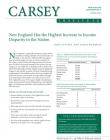
April 1, 2007
Income inequality in New England is rising at the highest rate in the nation, this brief finds. Between 1989 and 2004, the region experienced the largest increase in income inequality in the country, due to both growth among top earners and the hollowing out of the middle class caused by significant changes in the nation's economy.

March 20, 2007
New Hampshire has been successful in achieving one of the lowest uninsurance rates for children in the country - 6 percent in 2005 (U.S. Census Bureau). The extent to which New Hampshire Healthy Kids has contributed to the state's success in achieving this low rate is the focus of this brief.

February 19, 2008
New England is growing more slowly than the rest of the nation. The region is becoming more racially diverse, and demographic trends contrast sharply between northern and southern New England and metropolitan and rural areas. New England's population stood at 14,270,000 in July 2006, marking a gain of just 2.5 percent since 2000, less than half the national rate.

January 1, 2007
Biofuels play a crucial role in America's quest for oil independence. In recent years, the biofuel industry has seen significant technology and efficiency advances, as well as expansions in the materials that can be used to create biofuels. Grains and oilseeds are limited in their ability to meet fuel needs, but a shift to biomass feedstocks offers better production possibilities. For rural…

June 21, 2011
This brief examines where foster children are living four years after removal from their homes and the characteristics of these children and their placements. Understanding whether child characteristics such as age or emotional or behavioral problems are associated with a longer stay in out-of-home care can help identify children who are least likely to find permanence and may benefit from…
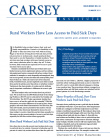
July 12, 2011
This brief, using data from the 2008 National Study of the Changing Workforce (NSCW) survey, analyzes paid sick time rates of workers by place and type of work. Paid sick days provide job protection to workers and a steady paycheck when they need to care for themselves or family members. Paid sick days also help workers with more limited resources who cannot otherwise afford to take a day off.…
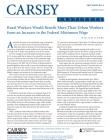
January 1, 2007
While members of the U.S. Senate considered the first increase in minimum wage in a decade, the Carsey Institute released findings of a study showing that it would benefit rural, low-wage workers every bit as much, if not more, than workers in big cities.
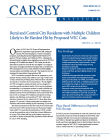
July 19, 2011
This brief uses data from the 2007 and 2010 Current Population Survey’s Annual Social and Economic Supplement to describe the distribution of the Special Supplemental Nutrition Program for Women, Infants, and Children (WIC) receipt across the population and to detail place-based differences in receipt. WIC is a nutrition program that serves pregnant or postpartum women, infants, and children up…
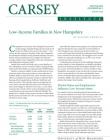
December 20, 2006
New Hampshire boasts the nation's lowest percentage of people living in poverty and maintains strong national rankings in other quality-of-life measures. But 48,000 New Hampshire families with low incomes struggle to make ends meet, this issue brief finds. The brief identifies characteristics that heighten families' risk of a lower income and documents recent trends in the economic…

November 28, 2006
Regions of rural America are being reshaped by growing numbers of immigrants who are choosing small-town life over the bright lights of the big city. This study found that immigrant settlers may have a big impact on small, rural communities—sometimes straining resources but also offering promise for reinvigorating dying communities.
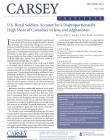
November 9, 2006
A study by the Carsey Institute found that among U.S. soldiers serving in Iraq and Afghanistan, those who are from rural America are dying at a higher rate than those soldiers who are from cities and suburbs. According to U.S. Department of Defense records, rural youth enlist in the military at a higher rate than urban and suburban youth and in all but eight states, soldiers from rural areas make…
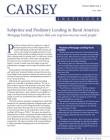
October 3, 2006
This brief examines predatory mortgage loans and the harmful impact they have on rural homeowners and their communities. The report finds that minorities and low-income people are more likely to fall victim to higher-cost loans. The brief includes recommendations for policy changes at the state and federal levels, as well as advice on identifying and avoiding predatory loans.
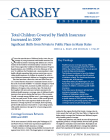
July 27, 2011
This brief uses data collected in 2008 and 2009 from the U.S. Census Bureau's American Community Survey (ACS) to examine changes in overall insurance coverage rates, as well as changes in types of coverage, and differences by region, state, and place type. The data show that together with new and more inclusive parameters for children's health insurance coverage, rates of children…

August 2, 2011
This brief from Chris Colocousis and Justin Young uses the most recent North Country CERA survey to focus on change and continuity in Coos County between 2007 and 2010, and then makes comparisons of the present conditions across the three study counties. The authors examine such topics as community problems, environmental and economic concerns, and community cohesion and confidence in the local…
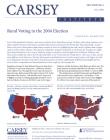
October 1, 2006
Rural votes can often make the difference between what party controls Congress and who is living at 1600 Pennsylvania Avenue. This Carsey fact sheet presents detailed patterns of rural voting by region and shows that these patterns are better explained by looking at demographic factors rather than simply by where people live.
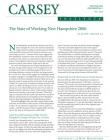
October 1, 2006
While New Hampshire has the highest labor force participation (71 percent) and the second-lowest unemployment and underemployment rates in New England, recent trends in employment and wages point to growing disparities in the state, this issue brief finds. The brief provides a state-focused analysis of the Economic Policy Institute's national report, “The State of Working America 2005/2006.”

October 1, 2006
The rural vote is critical, but how do rural voters' views on issues such as abortion, same-sex marriage, and religion influence elections? This brief compares rural and urban views on these divisive issues and examines how much rural opinions vary within rural regions of the country.
